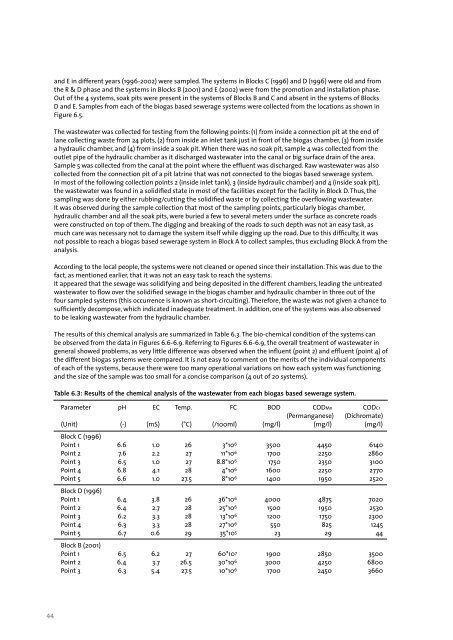Untitled - UNU-IAS - United Nations University
Untitled - UNU-IAS - United Nations University
Untitled - UNU-IAS - United Nations University
Create successful ePaper yourself
Turn your PDF publications into a flip-book with our unique Google optimized e-Paper software.
and E in different years (1996-2002) were sampled. The systems in Blocks C (1996) and D (1996) were old and from<br />
the R & D phase and the systems in Blocks B (2001) and E (2002) were from the promotion and installation phase.<br />
Out of the 4 systems, soak pits were present in the systems of Blocks B and C and absent in the systems of Blocks<br />
D and E. Samples from each of the biogas based sewerage systems were collected from the locations as shown in<br />
Figure 6.5.<br />
The wastewater was collected for testing from the following points: (1) from inside a connection pit at the end of<br />
lane collecting waste from 24 plots, (2) from inside an inlet tank just in front of the biogas chamber, (3) from inside<br />
a hydraulic chamber, and (4) from inside a soak pit. When there was no soak pit, sample 4 was collected from the<br />
outlet pipe of the hydraulic chamber as it discharged wastewater into the canal or big surface drain of the area.<br />
Sample 5 was collected from the canal at the point where the effluent was discharged. Raw wastewater was also<br />
collected from the connection pit of a pit latrine that was not connected to the biogas based sewerage system.<br />
In most of the following collection points 2 (inside inlet tank), 3 (inside hydraulic chamber) and 4 (inside soak pit),<br />
the wastewater was found in a solidified state in most of the facilities except for the facility in Block D. Thus, the<br />
sampling was done by either rubbing/cutting the solidified waste or by collecting the overflowing wastewater.<br />
It was observed during the sample collection that most of the sampling points, particularly biogas chamber,<br />
hydraulic chamber and all the soak pits, were buried a few to several meters under the surface as concrete roads<br />
were constructed on top of them. The digging and breaking of the roads to such depth was not an easy task, as<br />
much care was necessary not to damage the system itself while digging up the road. Due to this difficulty, it was<br />
not possible to reach a biogas based sewerage system in Block A to collect samples, thus excluding Block A from the<br />
analysis.<br />
According to the local people, the systems were not cleaned or opened since their installation. This was due to the<br />
fact, as mentioned earlier, that it was not an easy task to reach the systems.<br />
It appeared that the sewage was solidifying and being deposited in the different chambers, leading the untreated<br />
wastewater to flow over the solidified sewage in the biogas chamber and hydraulic chamber in three out of the<br />
four sampled systems (this occurrence is known as short-circuiting). Therefore, the waste was not given a chance to<br />
sufficiently decompose, which indicated inadequate treatment. In addition, one of the systems was <br />
<br />
also observed<br />
to<br />
<br />
be leaking wastewater from the hydraulic chamber.<br />
<br />
<br />
The<br />
<br />
results of this chemical analysis are summarized<br />
<br />
in Table 6.3. The bio-chemical<br />
<br />
condition<br />
<br />
of the systems can<br />
<br />
be observed from the data in Figures 6.6-6.9. Referring to Figures 6.6-6.9, the overall treatment of wastewater in<br />
general <br />
showed problems, as very little difference was observed when the influent (point 2) and effluent (point 4) of<br />
the <br />
different biogas systems were compared. It is not easy to comment on the merits of the individual components<br />
of each of the systems, because there were too many operational variations on how each system was functioning<br />
and the size of the sample was too small for a concise comparison (4 out of 20 systems).<br />
Table 6.3: Results of the chemical analysis of the wastewater from each biogas based sewerage system.<br />
44
















